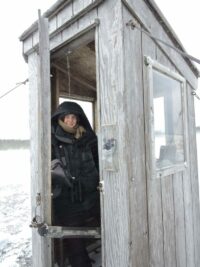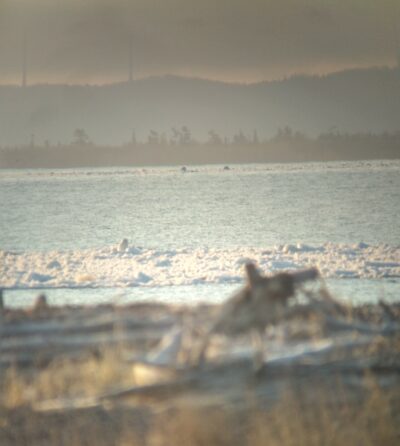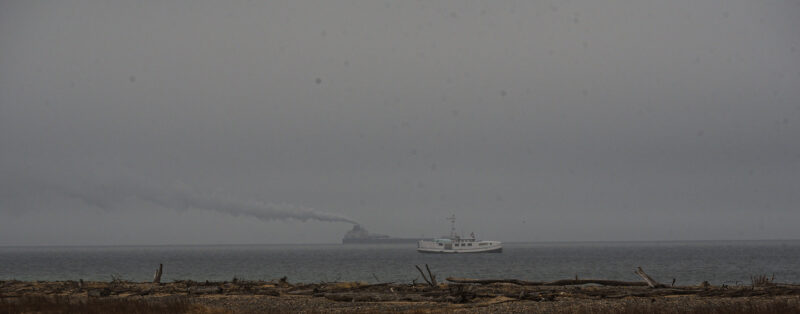 There is a certain urgency attached to spring migration on Superior. Many of the shorebirds and waterfowl that pass Whitefish Point Bird Observatory’s (WPBO) waterbird count are traveling to the Arctic’s tundra. Up there, the days are long — but the season is short. The span of days to establish a territory and raise the next generation is acutely finite. Birds passing the Point seem especially compelled to move north quickly. Here, migration happens round-the-clock.
There is a certain urgency attached to spring migration on Superior. Many of the shorebirds and waterfowl that pass Whitefish Point Bird Observatory’s (WPBO) waterbird count are traveling to the Arctic’s tundra. Up there, the days are long — but the season is short. The span of days to establish a territory and raise the next generation is acutely finite. Birds passing the Point seem especially compelled to move north quickly. Here, migration happens round-the-clock.
Migratory birds — and, by proxy, our work — are bound less to a human calendar than to weather conditions. At WPBO, we measure things less by day or date than by seasonal happenings. “The day the snow slid off the roof;” “The night the spring peepers started to sing;” “The day the loon flight peaked;” “The day the mosquitoes hatched.” In fact, when the time changes from Eastern Standard to Daylight Savings, our owl banders continue on standard time, calling it “Bird Time.” Conventional business hours are less important to these lines of work than are the boundaries set by lightness and darkness. In a way, all of us performing research at WPBO adopt Bird Time, and in spring, Bird Time sure does fly past.
Bird Time I (April 15–21)
On the first day of the spring waterbird count, the first birds are a Rough-legged Hawk and a flock of Bohemian Waxwings, species bound for points much further north. There is little evidence of either spring or water — in fact — my surroundings could pass easily for a scene on a holiday greeting card. Waterbirds are in short supply. But dark lines of dabblers, the first ducks to move through, trace the dark leads of water, traveling towards a season that right now just barely seems to exist.
Twice within this span of time, I see Snowy Owls nonchalantly riding ice floes that move slowly up Superior. I watch the owls sleep, preen, and yawn, all behaviors of birds irrefutably within their element. On the second day of the count, two Short-eared Owls grace my station. Shorties are always a delight to watch. The plumage is striking, the flight agile in the most lovely ways. But more than that, these birds are familiars. My interest in birds began at age 6. The first owl I saw that first spring of birding was a short-eared, and that short-eared set me down the path that has me at the tip of Whitefish Point during migration. It feels right to start the season being welcomed by a species with whom I have this history.
Bird Time II (April 22–28): Peak dabbler, Common Goldeneye, and Sandhill Crane flights.
On April 21, following a slew of days where snow blew and north winds howled, I drive to town and catch a weather forecast on the way — tomorrow’s actually going to be a nice day!
It is. Sandhill Cranes, more bound to thermals than the waterbird count’s other focal species, fly on “actually nice” days. And April 22, an actually nice day, brings our season’s sandhill peak. The cranes cross confidently; I lay down on the cobbles to watch. Overhead is filled with wild bugling, and over land and over water, crane flocks shimmer to the horizon. In roughly four hours, I tally 7,044 cranes. By the end of the season, I’ll have 13,118, which exceeds the previous high count (11,814 in 2016). During the waterbird count’s incipient years (1984–89), the highest spring total was just 287. In 2022, with the species much more numerous, I get more than that in a single flock.
Bird Time III (April 29–May 5): Peak Aythya, Bufflehead, grebe, and loon flights.
This is the time of the big loon push — for me, a favorite installment of spring. The loons are vanguards of migration’s opening floodgates, and everything is exciting this time of year, with each day bringing new arrivals. It’s thrilling to imagine so many Common Loons journeying to remote lakes on the Canadian Shield, the Red-throated Loons to the tundra of the coastal plain. The loon flight travels a much broader swath of sky and horizon than many of our other flights. Most waterbirds seem tightly bound to water, preferring to hug the lines of Superior. But loons, strong fliers, will just cut overland from Whitefish Bay to Lake Superior. They travel alone, in pairs, or in widely — but aesthetically — spaced flocks strung out across the sky like constellations.
Bird Time IV (May 6–12): Marbled Godwit; peak Surf Scoter flight; overall, a quiet period.
Poor weather, so long as the winds are from favorable directions, is great weather for waterbird migration. My favorite days are those when rain, clouds, and ducks all blow sideways up the lake — days so windy that I feel like I’ve got sea legs once I’m back inside, out of the elements. There’s something savage about standing out in eight hours of foul weather and feeling indefatigable. But the weather is mostly dry, mostly calm, mostly clear. My eyes beg for relief from the sun; my focus begs for duck flocks to catch, to sort.
Bird Time V (May 13–19): Peak Red-breasted Merganser & Bonaparte’s Gull flights; Marbled Godwit, Smith’s Longspur.
The lunar eclipse happens, and I go out to the beach to watch it. I arrive at dusk when Long-eared Owls are flying beneath emerging stars. Watching birds move between winter and summer at a vantage marked by the transition of land and water, light and dark, is powerful. Blinking lights from wind turbines and cell towers dot the otherwise dark Canadian and Michigan shorelines, testaments to our attachment to energy, to connectivity. Night-migrating Long-tailed Ducks fly north, yodeling, headed all the way to Nunavut, maybe.
The very Piping Plover chicks I stewarded here two summers ago court around me until I leave at 1 a.m. I’m delighted they’re back. Through my scope, I watch the moon’s passage to totality and back, reflecting on the accumulation of hours I’ve spent on this beach, the energy I’ve devoted to this place. At the moment the eclipse becomes total, Common Loons howl up and down Whitefish Bay. The night pulses with a connectivity and energy much deeper than the forms produced by wind turbines and cell towers.
Bird Time VI (May 20–26): Pacific Loon, uncommon shorebirds (Hudsonian Godwit, Willet, Stilt Sandpiper); peak Long-tailed Duck, White-winged Scoter, and Whimbrel flights.
On May 22, I tally 655 Long-tailed Ducks. The long-taileds pour out of a space between landforms we call “the gap.” When they disappeared into the gap last October, they wore winter: black and white, leaden water and ice. Now, in late May, they reemerge again, wearing summer: hues of tawny grass and dark muck. Watching birds enter the gap in fall, then emerge again in spring epitomizes migration’s mystique. The glimpses we get are fleeting, and there’s so much we don’t know. And this wonder of the not-knowing is a part of why I love Superior’s migrations.
The first flock of the Canada Goose molt flight passes the Point, signaling spring’s end. These birds, non-breeders, are headed up to James and Hudson Bays. There, they’ll molt. The geese are already losing flight feathers, and they look ragged. By this time, I feel ragged. Each day, the alarm gets earlier, the body protests harder, and even when I lay down to sleep, lines of waterbirds keep flying through my closed eyes.
Bird Time VII (May 27–31): Willet, Parasitic Jaeger, Pacific Loon; peak Canada Goose flight.
Black-bellied Plovers — stately, black and white — grace the beach. They’re headed to the tundra, and their call is beautifully melancholy. It pierces the soul as everything does at the end of the season. Count regulars, some of whom have visited for decades, hug me goodbye. I watch them disappear down the boardwalk, choke up a bit like I do when a shorebird flock departs the beach to the north.
Shorebirds are strong fliers and migration champions. Many of them travel not only between seasons but between hemispheres, too. They’re unthwarted by bad weather, confident in the Superior crossing. It takes quite foul conditions to ground a migrating shorebird flock at WPBO. And this spring, the weather has been comparatively mild. There hasn’t been a day when the freighters had to shelter in the bay, only a few days where I needed my worst-weather gear or to use the shack as a windbreak. My shorebird numbers have been low, and the season feels it’s missing something.
I finally get some weather — dense fog — in the count’s last days. From the shack, Superior isn’t visible. Five Whimbrels drop into the tip pond, shrilling. I stand up — summoned by a higher power, it feels — to observe. The flock builds to 66 Whimbrel, 62 Dunlin, 10 White-rumped Sandpipers, a Willet, and a Stilt Sandpiper, the first to be photographed in spring here. I treat every scope scan as a homage to the travelers, appreciating the graceful lines and long, pointed wings that make these marathon migratory flights possible.
Within the last half-hour of the count, the fog lifts and so do the birds, restless to go. A few days later, loading my truck, mosquitoes swarming, I feel that too. The shorebirds bear north; they rise, they fall, they cry out. My heart does all that, too. It runs better on bird time than it does on standard time.
I am deeply grateful to Nate Crane, Rhoda Johnson, Leonard Graf, Darrell Lawson, Alec Olivier, Evan Reister, and Matt Winkler, who all covered the count on various days so I could get time off. Together, we tallied 40,287 individual waterbirds of 70 species. This total is the second-highest in count history (behind 1997’s 42,262), but where 1997’s number is a diverse conglomerate of waterbird species, the 2022 total was dominated by Canada Geese and Sandhill Cranes. Together, they constitute 49.8% of the total.
Except for White-winged Scoter and Surf Scoter (below average) and Greater Scaup (average), waterfowl moved through in above-average numbers. New high counts were attained for Wood Duck, Green-winged Teal, Northern Pintail, and Hooded Merganser, and Ring-necked Duck tied its previous high count. Both Horned and Red-necked Grebes showed in numbers close to their cumulative averages. While Common Loon numbers continue to remain, as they have for the last decade, below average, Red-throated Loons were above average.
Shorebirds were a mixed bag. Some species like Whimbrel were well below average. Others, like Dunlin, were above. Some of the dense flights I expect in spring — like evening flights of scoters, Long-tailed Ducks, Bonaparte’s Gulls, and Whimbrel — didn’t happen, though we certainly were out looking for them! I suspect this is more because of a lack of weather events to concentrate these flights than it was reflective of populations.
Table: 10 most numerous species of spring 2022 waterbird count
| Species | First | Last | Peak | Total | Average |
| Sandhill Crane | Apr 15 | May 31 | 7044 (Apr. 22) | 13118 | 1893 |
| Canada Goose | Apr 15 | May 31 | 3237 (May 30) | 6934 | 2610 |
| Common Loon | Apr 15 | May 31 | 484 (May 5) | 3671 | 5233 |
| Red-breasted Merganser | Apr 15 | May 31 | 444 (May 19) | 2712 | 2585 |
| Long-tailed Duck | Apr 15 | May 30 | 655 (May 22) | 2201 | 1443 |
| White-winged Scoter | Apr 15 | May 31 | 320 (May 24) | 1636 | 1836 |
| Red-necked Grebe | Apr 18 | May 29 | 151 (May 5) | 691 | 630 |
| Bonaparte’s Gull | May 2 | May 31 | 169 (May 19) | 647 | 1375 |
| Greater Scaup | Apr 23 | May 19 | 118 (May 1) | 528 | 525 |
| Red-throated Loon | Apr 21 | May 31 | 71 (May 5) | 512 | 438 |
During the course of the waterbird count, 25,578 individual birds of 115 non-waterbird species were recorded. Of these, the most numerous were Blue Jay (9,344), Broad-winged Hawk (3,967), Sharp-shinned Hawk (1,466), Black-capped Chickadee (992), Common Grackle (752), American Pipit (746), Red-winged Blackbird (472), Yellow-rumped Warbler (464), and Turkey Vulture (425). A Smith’s Longspur on May 18 (seemingly the first WPBO record of this species since 2011) was the most unusual non-waterbird sighted this season, and appearances by Red-headed Woodpecker (May 14), Northern Mockingbird (May 16), Eurasian Tree Sparrow (May 23 & 25), and Brewer’s Blackbird (May 30) were enjoyed as well.
~ by Alison Világ, WPBO Spring Waterbird Counter
Featured photo: Trumpeter Swans by Alison Világ

When Alison Világ was six, her parents asked if she’d like to go look at ducks. Little did they know that day would be antecedent to a multitude of days spent looking at ducks, et. al. Both professionally and as a pastime, the pursuit of birds has taken Alison around the country and the world. Whitefish Point has long been an impactful place for Alison, and she was thrilled to return for a fourth season and continue her connection to the Point.
This section of the Jack Pine Warbler is dedicated to Michigan Audubon’s Whitefish Point Bird Observatory and features three articles illuminating the research conducted at WPBO this spring. This work focused on waterbirds (April 15–May 31), raptors (March 15–May 31), and owls (March 15–May 31).
As one of the three pillars of Michigan Audubon’s mission, research is at the heart and soul of what we do and integral to our value proposition. Whitefish Point ranks among North America’s most significant avian migration sites, and the observatory’s long-term research programs provide a picture of species dispersion, populations, demographics, movement, and more. This research is made possible through donations to Michigan Audubon that support our efforts to engage highly talented individuals to perform this work.
WPBO is located just north of Paradise, Michigan, along the shore of Lake Superior. The outdoor spaces of WPBO are open daily from dawn to dusk year-round. You can learn more at www.wpbo.org.




